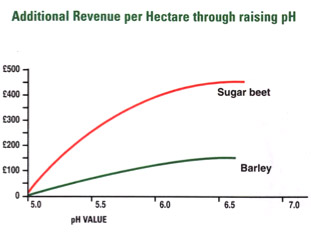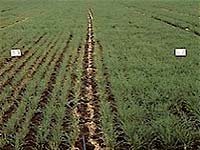Natural lime the best long term investment
The results from this liming trial (below) showed us that four years
after the initial lime treatments, further lime dressings were needed
on plots receiving the 11 t/ha (4.5t/acre) treatment. This is typical
of the normal liming interval for light-textured soils in low rainfall
areas.
The effects of the lime treatments on the growth and yield of sugar
beet, spring barley and spring wheat were monitored for three years. Acidity
symptoms were clearly visible in crops on the control plots which received
no lime but there was no root or leaf damage on any of the limed plots.
Crop growth was, however, more vigorous on the plots receiving the highest
rate of lime, showing low soil pH can have an adverse effect on growth,
even when no acidity symptoms are visible.
 Crop growth was also closely related to soil pH value and consistent
yield increases came with increasing soil pH in all four years of the
experiment. The yield responses resulting from an increase of 1 pH unit
were 9.2t/ha (3.7t/acre) of sugar beet in the first year; 0.7t/ha (0.3t/acre)
of spring barley in second year; 3.6t/ha (1.5t/acre) of sugar beet in
third year; and 0.2t/ha (0.8t/acre) of spring wheat in fourth year. Crop growth was also closely related to soil pH value and consistent
yield increases came with increasing soil pH in all four years of the
experiment. The yield responses resulting from an increase of 1 pH unit
were 9.2t/ha (3.7t/acre) of sugar beet in the first year; 0.7t/ha (0.3t/acre)
of spring barley in second year; 3.6t/ha (1.5t/acre) of sugar beet in
third year; and 0.2t/ha (0.8t/acre) of spring wheat in fourth year.
The economic benefit from liming was assessed by calculating the cumulative
value of the crop yield increases and comparing that with the cost of
the liming. Returns were adjusted to first year values.
The benefits of liming vary but the greatest returns will be achieved
by maintaining the soil pH in a narrow range within about 0.2 units of
the optimum pH value.
When the cost of lime is related to the long-term
benefits, it is one of the best investments you can make.
| |
pH 5.5 |
pH 6.7 |
 |
The benefits of lime applications to arable crops were investigated by ADAS in an experiment sponsored by the Agricultural Lime Association.
The trial site near Wetherby, North Yorkshire was on a sandy loam soil and had an initial pH value of 5.1 Lime requirement was 11t/ha (4.5t/acre).
The experiment assessed the effect of 0, 5.5, 11 and 22 t/ha (0, 2.2, 4.5, and 9t/acre) of screened limestone applied during first winter.
Soil analysis results confirmed progressive increases in soil pH values with increasing rates of lime application. The highest soil pH values were achieved in the first or second year after lime application. After that the pH level began to decline.
At no stage did the recommended dressing of 11 t/ha (4.5t/acre) achieve the target pH value of 6.7.
The results confirmed the reduced effectiveness of screened limestone compared with ground limestone. |
LIME IS A FERTILISER
The addition of lime helps to release soil nutrients. Fertilisers and
manure cannot be fully effective if the land is short of lime. In addition,
water that leaches from acid soils may contain undesirable materials which
can adversely effect the quality of surface and groundwaters.
Heightened environmental controls and regulations on the disposal of
sewage and other industrial wastes to landfill or sea outfalls have led
to an annually increasing volume of application to agricultural land.
These products do bring beneficial residual fertiliser and organic matter
to the soil. However, problems do arise as these wastes also contain a
number of metallic and other inorganic Potentially Toxic Elements (PTEs).
With repeated applications these contaminants accumulate in the soil and
can remain indefinitely, causing restrictions on plant growth, increased
uptake of metals by animals and man via the food chain and reductions
in soil microbial activity. Heavy metals become more available in acid
soils and adverse effects will then increase. When sludge or waste is
applied there will be a need to maintain alkaline pH values for an indefinite
period thereby inhibiting the release of heavy metals, whilst gaining
the manurial values of the material.
Agricultural lime is used to correct acidity and provide the right
conditions in which plants and aquatic life can develop. It has a major influence on:
- Plant development
- Efficient use of fertilisers
- Bacterial activity in the soil
- Animal health
- Water quality in rivers and streams
- Development of woodland areas
- Soil structure
- Efficient use of herbicides
|



